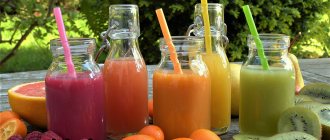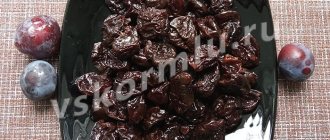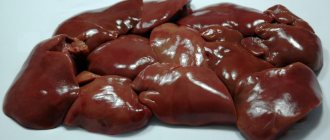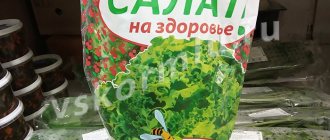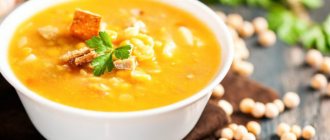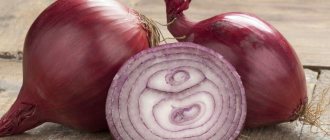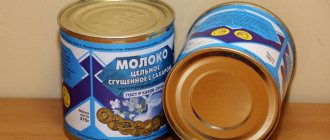Groundnuts are popular due to their valuable nutritional composition and budget price. However, when eating peanuts while breastfeeding, you need to remember that they are a strong allergen. The controversial product is introduced last in order to protect the child from negative reactions of the body to the nut. In the article we will look at whether it is possible to eat peanuts in the first month after giving birth, how to introduce treats so as not to harm the baby, what types of nuts are preferable for a nursing mother. At the end of the article there are recipes with peanuts that you can repeat at home.
Shelled peanuts are preferable to unshelled peanuts during breastfeeding.
Can I eat peanuts while breastfeeding?
If one of the parents is allergic to the product, it is better to avoid using it during breastfeeding. There is advice that you need to introduce groundnuts into the diet of a nursing mother as early as possible so that the child’s body gets used to the allergen. Nothing good will come from such an experiment, except skin rashes in the baby and problems with the gastrointestinal tract.
In the first month
Breastfeeding experts recommend completely eliminating any allergens in the first month of a newborn’s life. A nursing mother's menu should consist of the safest foods possible so that the baby's intestines digest food normally. High fat content of the product provokes increased gas formation and painful colic, since the baby’s digestive system is not sufficiently formed.
How to enter and how much to eat?
Before introducing peanuts into your diet, you need to try less allergenic varieties - pine or walnuts. Introducing peanuts is possible when the child is 4 months old. The first portion should be no more than 3-4 pieces. It is better to eat peanuts in the morning to monitor the baby's reaction to the new product. It is worth removing it from the diet if allergic symptoms appear:
- digestive problems (diarrhea, colic);
- coughing not associated with a cold;
- increased lacrimation;
- rash or redness of certain areas of the skin.
You cannot eat more than 10 nuts per week - even if the baby does not have allergies, this is not a reason to increase the permitted amount. If the baby reacts sharply to the innovation, the introduction of the product should be postponed for about a month.
How is it harmful?
Like any product, peanuts should be eaten only in small portions, otherwise the benefits can easily turn into harm. Also, we must not forget that peanuts are among the foods that provoke allergies. It is one of the three most powerful allergens. After giving birth, you need to start eating it very little, observing the reaction of the child’s body. A reaction to peanuts can result in anaphylactic shock, which poses a threat to the baby's life.
Due to the abundance of lipids and proteins in their composition, peanuts are difficult to digest and create a burden on the digestive system. It is best to add it little by little to various dishes, and not use it as an independent snack. You should refrain from salty and sweet options (in glaze), they have a bad effect on the functioning of the liver and kidneys.
Do not forget about the high calorie content of peanuts (570 kcal per 100 g), otherwise, with large portions, they can cause obesity. In addition, with excessive consumption of nuts, disruptions in the functioning of the pancreas and liver occur.
In what form will peanuts be useful for a nursing mother?
The largest amount of allergenic substances is contained not in the peanuts themselves, but in their skins - it is imperative to peel off the harmful shell before eating. It is better to eat groundnuts during breastfeeding as part of vegetable salads and main courses, and not as an independent snack. This will allow the beneficial substances to be completely absorbed without causing irritation to the gastric mucosa. Products with the addition of various flavors are strictly taboo, despite their attractive taste.
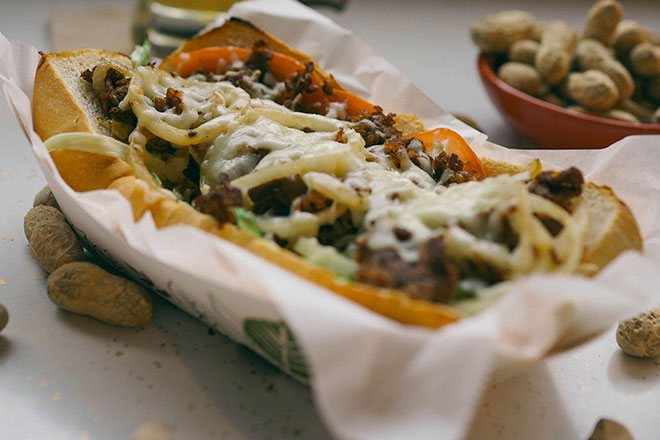
A snack in a baguette with peanuts will be more useful for a nursing mother than peanuts as an independent dish.
Raw
Raw peanuts are dangerous for the average person, and in case of breastfeeding, they are strictly prohibited. Mold develops on groundnuts, causing allergic reactions and intoxication of the body. A small heat treatment - frying in a dry frying pan - can neutralize the effect of microorganisms.
Fried
Roasted peanuts are much less likely to cause allergies, and they are absolutely safe for consumption during breastfeeding. It is usually not recommended to include fried foods in a nursing woman’s menu, but this means cooking them in vegetable oil. If you heat groundnuts a little in a non-stick frying pan, it will not become harmful food.
Salty
When breastfeeding, it is advisable to reduce salt intake, as it retains fluid in the body, which leads to edema. It is better to avoid salted peanuts during lactation. Additional stress on the kidneys and excretory system in tandem with the high fat content and calorie content of the product is a direct road to deterioration in a woman’s health.
Peanut paste
Peanut butter was invented by Canadian nutritionist Edson - and the delicate creamy dessert has already gained popularity around the world. The paste is made from roasted peanuts, so it is not highly allergenic. However, the caloric content of the product will not allow a woman to quickly return her figure to normal after childbirth. When buying pasta, it is important to pay attention to the quality of the dessert. The composition should not contain:
- Low quality fats (palm oil). This dubious raw material is used to reduce the cost of the final product, and there can be no talk of any benefits to the body.
- Artificial preservatives (the most dangerous are E220, E211, E222, E250). It is impossible to do without preservatives in industrial food production, but it is better to choose pasta with natural preservatives. Additives of synthetic origin pose a serious health hazard, especially during breastfeeding.
- Synthetic sweeteners (E950, E951, E952, E955). They have a carcinogenic effect on the body and provoke gastrointestinal disorders.
When breastfeeding, you should introduce peanut butter with ½ teaspoon, carefully observing the baby's reaction.
Rules for use during breastfeeding
In order to choose good peanuts, it is important to pay attention to the following characteristics:
- date of manufacture and expiration date;
- information on the packaging about the absence of GMOs in the composition;
- the surface of the nut must be clean and smooth, without damage;
- no mold odors;
- if the peanuts are not peeled, then when shaking the sound should be dull, a ringing knock means that the kernels have dried out due to improper storage;
- a bright yellow color also indicates that the product is stale.
Often, unscrupulous manufacturers can change the usual composition of peanut butter, adding sweeteners, palm oil and other harmful substances to it.
Therefore, store-bought paste can turn out to be quite a dangerous product if you do not pay attention to it.
Attention!
Peanuts, in their chemical composition, are rich in vegetable proteins and unsaturated fats; such food creates a large load on the liver and stomach. Therefore, eating fresh nuts in handfuls is not recommended.
The worst digestible foods for the body are salted peanuts and sugar-coated nuts. In addition, salt is not at all recommended for nursing mothers, as it promotes water retention in the body and the appearance of edema and reduces the quantity and quality of breast milk.
It is better to eat oven-roasted nuts by chopping them and adding them to salads or hot dishes. This method will protect the gastrointestinal tract from unwanted disturbances and the product will be absorbed, bringing only benefits to the body.
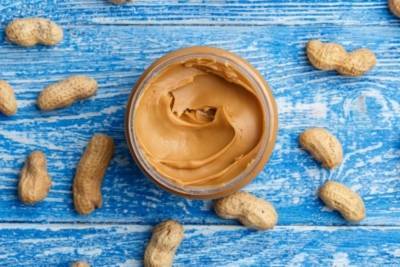
Experts recommend limiting peanut butter consumption to 20 grams per day. The same goes for nut kernels, the daily norm is 20 grams, which is about 10-15 nuts. This amount is quite enough to provide mother and baby with the necessary nutrients.
It is also important to remember about the high calorie content of peanuts: 100 g of the product contains 570 kcal; consuming it too much can threaten to put on extra pounds. Peanuts are, without a doubt, beneficial for a nursing woman and her baby, subject to certain rules and moderate consumption
When introducing a new product into your diet, you should always treat it with great seriousness and responsibility; it is advisable to obtain recommendations from your doctor
Peanuts are undoubtedly beneficial for a nursing woman and her baby, provided that certain rules are followed and consumption is moderate. When introducing a new product into your diet, you should always treat it with great seriousness and responsibility, and it is advisable to obtain recommendations from your doctor.
Benefits and potential harm
Peanuts in the diet provide the necessary amount of unsaturated fatty acids, vitamins and microelements:
- Groundnuts contain plant protein that supports healthy cartilage and bone tissue. When breastfeeding, a woman's skeletal system and joints are under attack, and a small portion of peanuts restores protein deficiency.
- Vitamin D - prevention of childhood rickets.
- Retinol supports women's beauty during breastfeeding.
- B vitamins are responsible for the normal functioning of the nervous system.
- Ascorbic acid protects against colds.
- Vitamins A and E improve the condition of hair, skin and nails during breastfeeding.
- After childbirth, the risk of varicose veins increases, and peanuts prevent the appearance of cosmetic problems.
- The work of the heart muscle is stabilized, blood quality improves, and cholesterol is eliminated.
- Peanuts are a natural antioxidant that supports health at the cellular level.
- The permitted amount of groundnuts contains a daily dose of iron - mother and breastfeeding baby are not afraid of anemia with such a reliable helper.
The female body must fully recover after pregnancy and childbirth, so both the beneficial properties of groundnuts and possible harm are taken into account:
- Peanuts are poorly digested and take a long time to digest, which causes problems with a weak digestive system in the baby.
- It is not advisable to eat peanuts while breastfeeding if a woman has been diagnosed with liver, kidney or stomach diseases.
- The fatty and caloric content of peanuts causes disruptions in the gastrointestinal tract: flatulence, diarrhea or constipation, bloating.
- The phytic acid content reduces the absorption of nutrients, so you should not overuse peanuts.
During breastfeeding, you should avoid glazed peanuts.
How does eating these foods affect the body?
Nursing mother
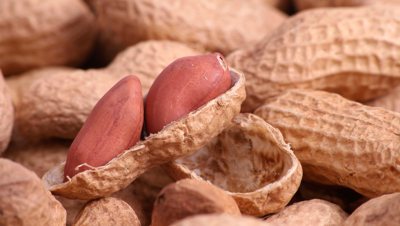
By adding peanuts or peanut butter to her diet, a woman ensures more effective recovery after childbirth thanks to the positive properties of the nut:
- stretch marks after childbirth become more invisible and disappear;
- the skin becomes more elastic, the ability to regenerate is activated;
- prevention of postpartum anemia, thanks to the content of iron and copper;
- anti-inflammatory and antibacterial effect;
- positive effect on the female nervous system, helps increase stress resistance;
- strengthens blood vessels, serves as a preventive measure against varicose veins.
child
When consuming nuts, the composition of breast milk improves, it becomes more caloric and enriched with important microelements necessary for the successful development and growth of the baby.
Vitamins B, C, E and many others, contained in large quantities in groundnuts, have a beneficial effect on the formation of the child’s internal organs.
Reference
Peanuts are rich in proteins, which are necessary for the development and strengthening of the bone skeleton, joints and muscles. And the calcium, magnesium, potassium and other microelements contained in it are simply necessary for the full development of the child’s body.
Selection and storage
During breastfeeding, it is better to buy nuts in shell, using valuable recommendations:
- the shell must be intact without visible damage (stains, cracks and other defects);
- when shaking peanuts, a dull sound occurs (a loud sound indicates violations of storage conditions);
- mold and dirt are a bad signal, characteristic of damage to the product by insects or fungi.
Peeled peanuts must be chosen no less carefully:
- there is no condensation or foreign debris in the packaging;
- the size of the peanuts should be the same and the packaging should be tightly sealed;
- It is better not to buy darkened or wrinkled nuts.
High-quality shelled peanuts are never wet.
Improper storage gives the product a bitter taste and provokes mold, which is dangerous for the baby and mother during breastfeeding. In the shell, groundnuts retain their properties longer:
- Damaged and spoiled peanuts with wrinkled and darkened shells are first removed.
- Peanuts should be heated for no longer than 10 minutes in the oven at 50 °C. Additionally, glass or ceramic storage containers need to be sterilized.
- It is convenient to store groundnuts in the refrigerator or freezer, placing them in dry cloth bags.
Peanuts should not be stored:
- in plastic containers;
- in plastic bags;
- in original packaging after opening - such nuts should be eaten immediately;
- in crushed form;
- open in the refrigerator - peanuts will absorb all foreign odors;
- sweet, salty and fried.
If a groundnut has changed its appearance, taste or aroma during storage, you need to get rid of it. Consuming a spoiled product while breastfeeding can lead to serious poisoning. For storage, you need to choose a dry, cool and dark place, and the container should be tightly closed. The shelf life of peanuts in the shell is about 12 months, shelled - no longer than 6-9 months.
Healthy recipes with peanuts for breastfeeding
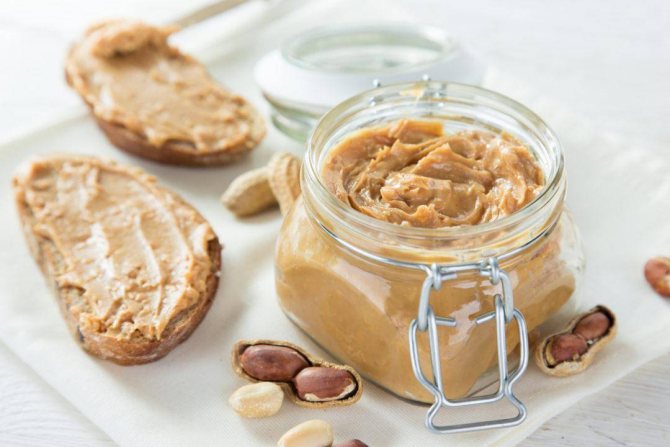
To get all the benefits of a tasty and aromatic nut, you can make your own peanut butter.
It requires the following products:
- 200 g peeled nuts;
- 50 g butter;
- 3 tsp. Sahara;
- 0.5 tsp. salt.
The nuts need to be rinsed with water and blotted with a paper towel. Then dry in the oven for 6-7 minutes at 180 degrees. This will be enough time for them to prepare. When the nuts have cooled, pour them from the baking sheet into a bag, tie them up and shake well. This technique will make it easier to remove the husk. The nuts must be sorted very carefully, all shells removed, and then ground into a homogeneous mass using a blender. Finally, add sugar, salt and butter to the mixture and mix. Store the product in the refrigerator.
Another sweet but tasty product is peanut candy. To prepare them, you need to take:
- 150 g peanuts;
- 150 g walnuts;
- 200 g chocolate;
- 15 pieces of dried apricots;
- 2 tbsp. l. sesame seeds.
Peanuts and walnuts must be dried in the oven at 180 degrees for 5-7 minutes, remove the thin peel. Heat the chocolate in a water bath until it melts. Mix washed and dried dried apricots with nuts and grind in a blender until fine crumbs. Add chocolate, stir. Form sweets from the viscous mass using your hands or a spoon and roll them in sesame seeds. After cooling in the refrigerator for 30 minutes, they are ready to eat.
It is also beneficial to add nuts and dried fruits to porridge. To do this, wash the nuts and dried fruits and pour boiling water over them for a few minutes. Then chop and add to the finished hot porridge. It is very tasty to add groundnuts and dried apricots to rice porridge. Fragrant nuts transform its bland taste.
Peanuts can and should be included in a woman’s diet during pregnancy and breastfeeding, but only if there is no allergy to it
It is also important to monitor your baby’s reaction to this new product and adhere to the recommended daily dosage of nuts.
Recipes
It is not easy to find truly healthy peanut butter on supermarket shelves, since not all manufacturers are honest about the composition of the product. If you prepare the dish at home, you will get a tasty, healthy and absolutely safe dessert for breastfeeding.
Peanuts can be useful for breastfeeding, if you take into account the individual characteristics of the body. It is impossible to completely eliminate the possibility of allergies, so it is important to include the product in the diet no earlier than the specified period. The baby's health should remain a priority, not the mother's gastronomic preferences.
Norms of use and contraindications
Contraindications to the use of nuts are mainly associated with exceeding the daily norm. Abusing them can affect your weight, but for this to happen, you will have to try very hard and eat literally kilograms of nuts. The product should not be eaten if you have varicose veins, thrombophlebitis and vascular diseases . It thickens the blood and slows down circulation.
Which nuts should you choose? It is best to consume raw peanuts without additives. You can buy it where dried fruits are sold.
Nuts with salt and spices, which can be found on shelves with crackers and chips, are not what you should eat during lactation; they contain preservatives, synthetic flavors and will not bring any benefit to either mother or child.
For an adult, it is optimal to eat about 20 nuts per day to get maximum benefits. This will help you stay toned and less tired. Peanuts can be eaten during lactation in the same quantity, if there are no contraindications or intolerance. Vitamins and minerals of natural origin will enable the young mother to cope with the load.
Introducing peanut dessert into the diet
Due to the allergenicity of the product, it can be added to the diet only after the baby reaches three months of age - by this time his digestive system will have time to get stronger.
A new product is introduced into the menu according to the standard scheme: the mother should eat a small amount of paste (no more than half a teaspoon) immediately after morning feeding and monitor the child’s well-being for two days.
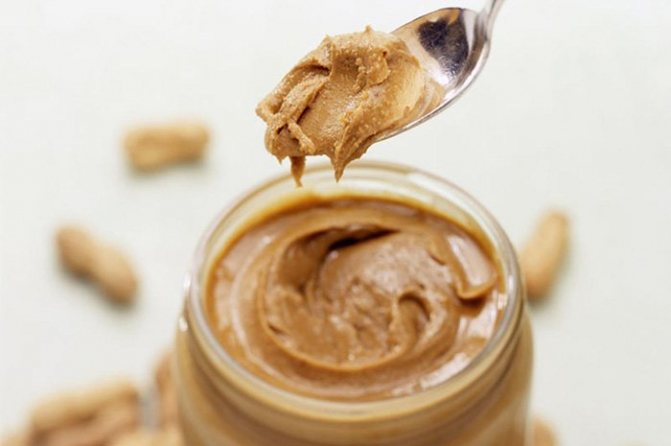
The absence of allergic rashes and redness of the skin, the baby’s normal digestion allows you to gradually increase the amount of dessert eaten to 20 grams per day. This is enough to enrich the body of the mother and baby with substances beneficial to health.



